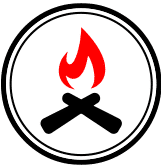Every year during opening weekend of firearms season, biologists with the Indiana Department of Natural Resources show up at check stations around the state to compile information regarding the age and sex structure of that weekend's deer harvest. This information provides a valuable sample for determining how the state's deer population has changed since the previous hunting season. Determining a deer's sex is simple enough, but aging a deer requires special training and knowledge of when a deer's milk teeth (baby teeth) are replaced by permanent teeth, and how the teeth wear throughout time. Deer older than yearlings are aged through wear of the cusps closest to the tongue on the cheek teeth. By looking at characteristic patterns of teeth replacement and wear, biologists can estimate the age of your harvested deer.
The following information is being provided by the Indiana DNR for hunters to use as a tool in the field to determine the age of their deer. Before continuing, it is necessary to outline the terminology that will be discussed.
- Premolars- teeth 1, 2, and 3, used for cutting food
- Molars- teeth 4, 5, and 6, used for grinding food
- Enamel- the hard, white outer surface of the tooth
- Dentine- the soft, brown inner core of the tooth
- Infundibulum- hollow portion in the middle of the tooth, often contains food residue
- Tartar- brown staining on outside of teeth


Guide
- 0.5 Years (Fawn)
Fawns have less than 6 cheek teeth. Typically, the deer has 4 cheek teeth if it is 5 to 6 months old, and 5 cheek teeth if the deer is 7 months to one year old.

- 1.5 Years (Yearling)
Yearlings and older deer will have 6 cheek teeth. Yearlings can be identified by looking at the replacement of the temporary tricuspid third tooth with a permanent bicuspid tooth. A yearling can be identified by one of any three possibilities:
1. The third tooth is tricuspid (3 ridges on the side) and heavily worn. This is the milk premolar that has yet to be replaced by the permanent tooth that will be bicuspid (two ridges on the side);


2. The permanent third tooth is erupting from the gum line and is lower than the other cheek teeth;


3. Or, the permanent third tooth is bicuspid (two ridges on the side), but lacks tartar or staining and is whiter than the adjacent molar. All of the crests on the last three teeth (molars) will have very little wear.


- 2.5 to 3.5 Years
2.5 Years
Deer older than yearlings are aged through wear of the cusps closest to the tongue on the cheek teeth. For 2.5 year olds, the third tooth is bicuspid and stained. The fourth tooth shows little wear, having a defined point, and the brown dentine is thinner than the white enamel.


3.5 Years
The enamel on the fourth tooth has worn away so that the dentine is now as wide or wider than the enamel. The fifth tooth doesn't have as much wear, and the dentine on that tooth is not as wide as the enamel.
 >
>
- 4.5 to 5.5+ Years
4.5 Years
The enamel on the fifth tooth has worn away, and the dentine is now wider than the enamel on both the fourth and fifth teeth. The last tooth still maintains enamel wider than the dentine, since it hasn't worn away as much as the previous teeth.


5.5+ Years
All cheek teeth are beginning to show heavy signs of wear, and aging at this point becomes very difficult. In all teeth, the dentine is wider than the enamel. Only a small amount of enamel will remain on the third and fourth teeth. Cusps are dulled and teeth appear much more flat. Older deer will have dentine showing prominently when viewed from the top. All deer experiencing these tooth characteristics are lumped together in a 5+ year old category.
>


